Yosemite National Park is arguably the most beautiful national park in the world. There are tons of hikes, scenic drives, viewpoints, and other things to see in the park that planning can be a little overwhelming.
This article will show you 25 of the best things to do in Yosemite National Park that will help you plan our your visit and make the most of your visit.
You’ll see some of the best waterfalls, hiking trails, and places to photograph the park and I’ll give you my recommendations for lodging/hotels as well.
1. The Merced River (HWY 140 Route)
One thing I really love about this park is the drive along the Merced River while you are coming in from HWY 140. There are a number of turn-out points that give you great views of the rushing river.
And don’t hesitate to work your way down the river bank to get up close and personal with the Merced and get some interesting photos. Trust me, it will be completely worth your time, just don’t wander too carelessly down the rocks.
Coming in from Highway 120 is also extremely scenic. You are not down by the river but you are much higher and therefore able to soak in beautiful views of the canyon scenery!
Tip: Use the free app WalletFlo to help you travel the world for free by finding the best travel credit cards and promotions!
2. Tunnel View
You’ll see more photos of this view than maybe any other view of Yosemite and perhaps even of any other national park. Coming into the park from HWY 41, you’ll drive through a tunnel and then pop out to the spectacular view. The look out point will be on the left and you owe it to yourself to stop.
When I visited in late March, there was hardly anyone in the parking lot at around 10am. However, if you come during peak season in the afternoon (August or September) I’m sure the lot will be overflowing so consider that. If you’re just looking for an amazing view then seeing the view at any time of day will do.
However, if you are a serious photographer then you want to catch the sunrise that will rise right over the valley or catch the sunset when the sun beams off the granite walls in a beautiful bright hue of orange and red. Often times in the evenings, low lying fog blankets the valley providing for exceptional photograph opportunities.
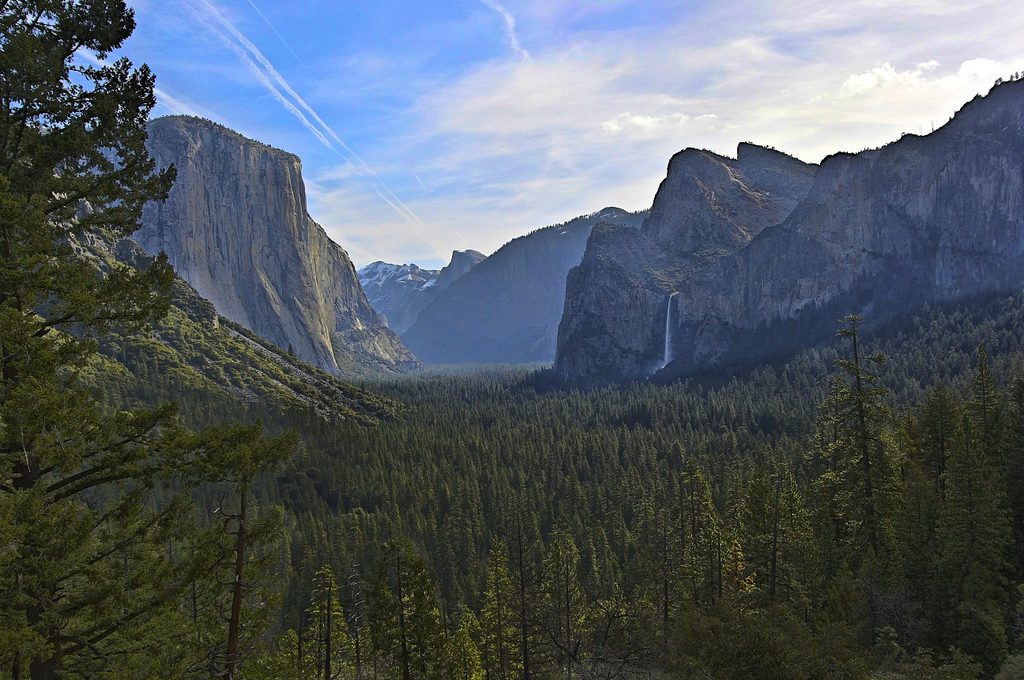
3. Sentinel Bridge
Sentinel Bridge is a must-see stop for all photographers and people who just want to enjoy a spectacular view.
There’s a small parking lot that I’m sure is overrun during peak season, but during the spring we had no problem grabbing a spot and were met at the bridge by only two other photographers.
Photography Tip: If you only have one night, then you’ll want to utilize your one sunset as best as you can. So in the evening get shots from Tunnel View first, then move to Sentinel Bridge to catch the sun beaming off Half Dome.
That way, from Tunnel View, you can capture the fog that may be blanketing the valley floor before it gets too dark.
Alternatively, if you have multiple nights, then you could shoot from Tunnel View one evening and then Sentinel Bridge the next. Of course, there are also other options for great sunsets shots in the park.
Related: REI Co-op World Elite Mastercard Review
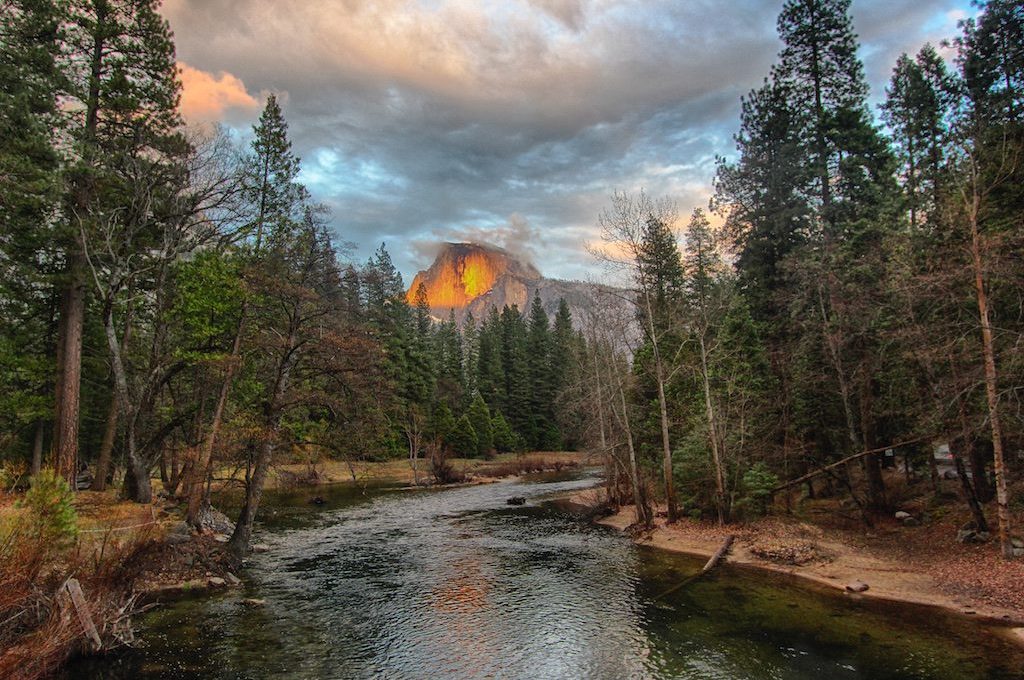
4. Hetch Hetchy
Hetch Hethy is a beautiful reservoir but with a heartbreaking past. It’s a glacial valley in the northwestern part of Yosemite National Park and is drained by the Tuolumne River.
Believe it or not, it was actually a valley that rivaled Yosemite Valley in its beauty but in 1923, the O’Shaughnessy Dam was completed on the Tuolumne River, which flooded the entire valley. The reservoir began providing tons of water to the San Francisco Bay Area but it did come at the cost of losing the valley floor.
Some popular places to check out in this area are: the O’Shaughnessy Dam, Wapama Fall, and Smith Peak. You can find more things to do in this area here.
5. Tioga Road
Tioga Road is a road through Yosemite’s high country that offers many spectacular views and has a host of attractions to check out along the way.
Some points of interest you might want to check out are: Siesta Lake, White Wolf Campground, Yosemite Creek Picnic Area, Olmsted Point, Tenaya Lake, and Soda Spring. This is also one way to get to the trail head for the amazing Cloud’s Rest hike.
Tenaya Lake has some stunning, post-card worthy views and it’s one of the easiest lakes in Yosemite to get to. This road will only be open late May or early June so it is best for summer visits.
6. Tuolumne Meadows
Tuolumne Meadows is located off Tioga Road and it offers some great hiking options. These include:
- Tuolumne Meadows: Soda Springs and Parsons Lodge
- Lyell Canyon via the John Muir Trail
- Elizabeth Lake
- Gaylor Lakes
- Cathedral Lakes
- Mono Pass
- Glen Aulin
- Dog Lake and Lembert Dome
7. Yosemite Falls
Yosemite Falls is the tallest waterfall in North America at 2,425 feet. Not only is its height impressive but the sound of the roaring water of the falls can be heard from around the park. This is especially true if you visit April through June.
I suggest visiting a time other than August because that is that often when Yosemite Falls will be dried up. It’s such a loud and powerful waterfall — you really want to catch it in all of its glory if you can.
You can get up close to the falls by doing the easy Lower Yosemite Falls Trail or by doing the much more strenuous Upper Yosemite Falls Trail. Upper Yosemite falls has over 100 switchbacks and so it is best attempted when you have some decent conditioning but you do not have to go all the way up to the top to get the great views!
And have you ever heard of “moonbows?”
That would be a rainbow seen at night caused by the light reflected from the moon. Yosemite Falls is one place where they are visible, though you’ll have to catch them when the moon is bright.
This video showcases them very well.
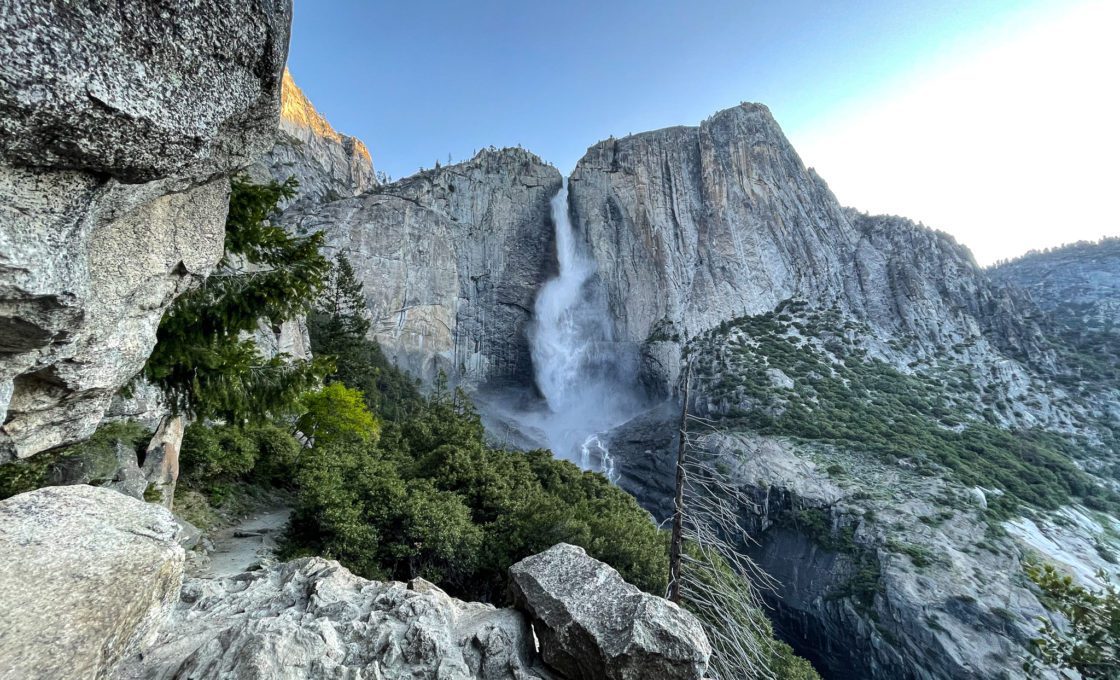
8. Sentinel Falls
You can find this waterfall on the south side of Yosemite Valley, just west of Sentinel Rock. It’s a beautiful waterfall with multiple cascades, ranging in height from 50 to 500 feet.
You can check out this waterfall from areas along Southside Drive near the Sentinel Beach Picnic Area, and near the Four Mile Trailhead. You can also view it from Yosemite Valley near Leidig Meadow, or when hiking the Upper Yosemite Fall Trail.
Tip: Use the free app WalletFlo to help you travel the world for free by finding the best travel credit cards and promotions!
9. Horsetail Fall
Horsetail Fall is a 1,00 foot waterfall that usually flows from approximately December through April. It’s famous for the orange glow that is usually produces in mid- to late-February when the sun casts its glow at just the right time in the evening.
The NPS notes that to see Horsetail Fall, park at the El Capitan picnic area (on Northside Drive west of Yosemite Valley Lodge, formerly Yosemite Lodge) or in turnouts just east of the picnic area. You can see the waterfall from the road.
10. Bridalveil Fall
Bridalveil Fall usually flows year round with a peak flow in May.
This is often the very first waterfall you’ll encounter when you enter the park. You can see it from near the tunnels on the Wawona Road (Highway 41) or Big Oak Flat Road (Highway 120) and from a signed parking lot on your way into Yosemite Valley.
You can also walk to the base of the falls via a short but relatively steep trail that only takes a few minutes.
11. Half Dome
The most iconic image of Yosemite has got to be Half Dome. Just viewing it at any time of the day is impressive, especially when it’s snow capped in winter.
Half dome permits
I’m a big advocate of visiting in the spring, but the good thing about visiting the park in the summer is that you can apply for a permit to climb to the the top of Half Dome, which would be amazing and is on my bucket list.
A maximum of 300 hikers are allowed (about 225 day hikers and 75 backpackers) each day on the Half Dome Trail beyond the base of the subdome. Permits are distributed by lottery at Recreation.gov (or call (877) 444-6777) and they have one preseason lottery with an application period in March and and daily lotteries during the hiking season.
If you have a lot of flexibility, you’ll find it much easier to secure a permit to hike Half Dome and you can find out more about which says will be easiest to get a permit here.
And for any people out there who don’t know, Half Dome is the inspiration of the North Face logo you see everywhere (not to be confused with South Butt).
Half dome sunsets
But you don’t have to climb to the top of Half Dome to witness its magic. Try watching the sun’s burning glow off the north face at sunset.
I ran into some rain and bad cloud coverage the evening I set up to take shots but the clouds broke for a few minutes to let me get some shots of the sunlight cutting across the north face, so don’t be discouraged if you run into a cloudy day there you may still have a chance.
12. Snowshoeing in winter/spring
I first strapped on snowshoes in my first visit to Yosemite in March of 2013 and it was quite the experience, mostly because we got severely dehydrated due to our hiking ignorance and after getting lost we had to actually depend on a compass to find our way through the backcountry (also due to our hiking ignorance).
There are ample snowshoe opportunities here up until the end of March. Of interest to many are the ranger led snowshoe hikes, including the moon-lit hikes they have on the nights leading up to a full-moon.
You can rent snowshoes from Badger Pass or bring your own. And if you’re into more challenging routes, look to the winter backcountry routes heading around the Glacier Point Road area.
13. Yosemite Ski & Snowboard Area (formerly Badger Pass)
Yosemite Ski & Snowboard Area, formerly known as the Badger Pass ski area, is a ski area that offers slopes fitted for beginner skiers and also is a place to start off for backcountry snowshoeing and cross country skiing. It’s usually open mid-December to late March.
We started our snowshoeing hike to Dewey Point from that area.
Don’t forget to get the most up to date conditions for Badger Pass before going out there because they do not have artificial snow up there and note that chains may be needed to get up there.
You can check up on the latests conditions by calling the Snow Phone at (209) 372-1000.
14. Half Dome Village (formerly Curry Village)
Half Dome Village, formerly known as Curry Village, gives you the chance to experience a more rustic experience without the hassle of dealing with setting up your own tent or securing a backcountry permit.
They have different lodging types including:
- Canvas Tent Cabins – Unheated
- Canvas Tent Cabins – Heated
- Yosemite Cabins with Bath
- Stoneman Standard Rooms
If you’re staying in the park when it gets really cold at night, you’ll probably want to do what we did and reserve a tent with a heater. It’s a little extra $, but you’ll be hella toasty. The only drawback is that the tents are pretty close together so it can be difficult to fall asleep due to all the (sometimes drunken) chatter outside.
I do feel obliged to mention two, shall we say… “incidents” about the former Curry Village, though.
First, this happened: Falling boulder risk forces Yosemite closures.
Second, this happened: Yosemite closes Curry Village cabins after hantavirus outbreak.
With that said, I’d honestly be willing to stay at Half Dome Village again in a heartbeat.
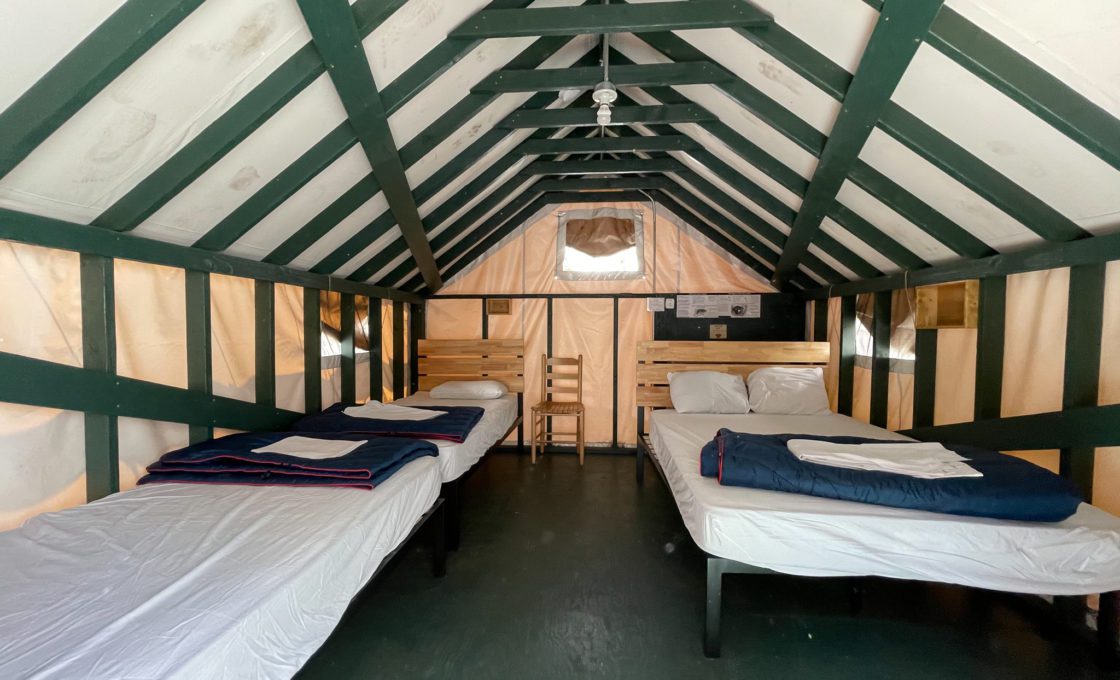
15. Yosemite View Lodge
After spending a night in Curry Village, the city-dweller in me was ready to move on up a little bit. So we booked a night at Yosemite View Lodge, and I loved this place. It’s about 20 minutes outside of the park but the rooms are fantastic.
We stayed in a King Suite room complete with a fire place, huge two-head shower, hot tub, and balcony view of the Merced river. Not all rooms have the river view so you will have to request it.
The Lodge has a pizza restaurant adjacent to one of the buildings and the pizza is really good, and I think there’s also another restaurant there as well. This lodge was perfect after a long couple of days of hiking to relax in.
If you’re into the more luxurious type of stay (and your budget permits), then you’ll likely want to stay at the Ahwahnee Hotel, located inside Yosemite National Park.
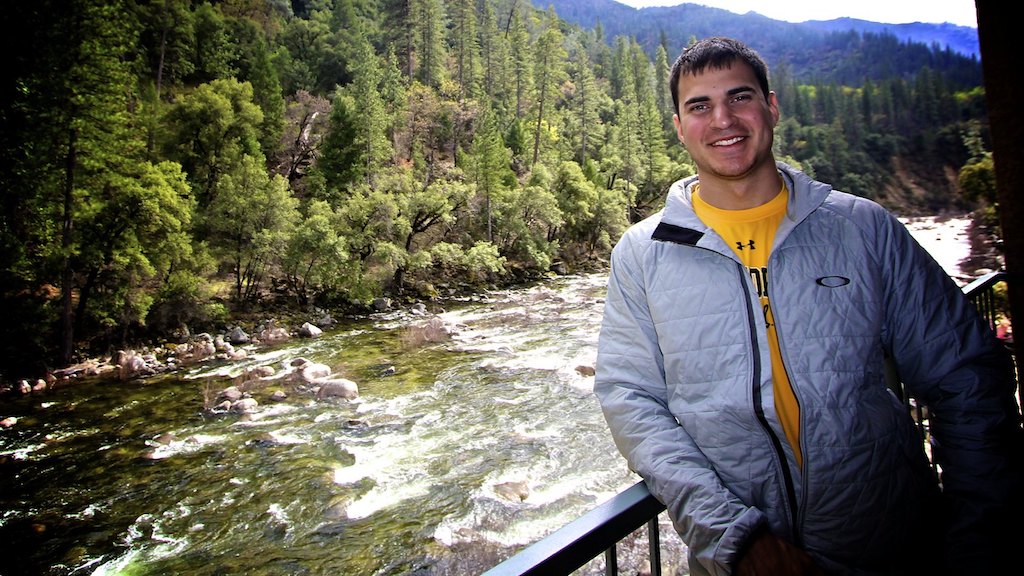
16. Driving or walking around the valley
If you aren’t into strenuous hikes or maybe just want to relax a little then just driving or walking around the park and taking photos can be good way to take in Yosemite.
I’d recommend stopping by all of the waterfalls you can access and even relaxing in the meadows taking in views of the granite monoliths, such as the 3,000 ft. face of El Capitan.
If you see little shiny spots on any of the monoliths, know that you are witnessing some brave rock-climbers work their way up the side of the walls. For a granite wall like El Capitan, it takes climbers multiple days to make it to the top. Check the shuttle schedule in the park to avoid the congestion and parking issues.
If you’re a photographer there are endless possibilities for shots around the valley floor. But even if you’re just looking for beautiful backgrounds for your family photos or yes — even selfies — it’s a good idea to wander around the meadows and streams for good shots and take in the fresh scents of Yosemite.
Also, the meadows are home to some wildlife and you wouldn’t believe how sociable some of the animals are. Picture your most sociable friend. Now imagine that person as a deer. That’s how the deer act at Yosemite.
When we were in a meadow we came across the most sociable deer I’ve ever seen. And if you’re really lucky, you may come across a bear, just hope it’s not as outgoing as the deer.
17. Frazil ice (spring only)
Frazil ice is a phenomenon that happens in the spring when ice forms from frozen mist from the falls and then passes down along the streams. As the ice flows, it collects into big bunches of slushy ice that then turn into snow… expect it’s not really snow and if you step on it you will die.
Confused? Scared? Check out this amazing video made by the National Park Service and you’ll see what I’m talking about. I’d never seen anything like it — and it can best be spotted in March and April.
18. Mariposa Grove
Mariposa Grove is an area in Yosemite known for its Giant Sequoias, which are trees native only to the western slopes of the Sierra Nevada mountains of California and grow to be the biggest trees in the world not to mention around 3,000 years old.
The Grove is near the southern most entrance to Yosemite (HWY 41), so if you enter that way and want to see Sequoias you might as well go straight to it because it is a little ways from the Valley.
The entire Grove just underwent a huge renovation project which was initiated to help protect the Sequoia trees. Now, you’ll need to arrange for shuttle transportation to check out the grove.
At the Grove, we saw the Grizzly Giant, the 25th largest giant sequoia, among other wooden giants. However, if you really want to see sequoias, including the largest tree in the world, then make the trip up to Sequoia National Park.
19. Glacier Point
Glacier Point is an area of Yosemite where you have superb views of Half-Dome and the entire valley. This is a must see spot but just be ready for crowds.
I’ve seen a ton of amazing photographs taken from this point so if you are there in the summer definitely check it out and look into the astronomy tours just mentioned.
Glacier Point is accessible by car from approximately late May through October or November. From the Glacier Point parking area, there’s a short, paved, wheelchair-accessible trail that takes you to the viewpoint which sits 3,214 feet above Half Dome Village.
You can also hike up to the viewpoint via the 4 mile trail. The round-trip is about 9.6 miles and 3,200 feet in elevation gain so it is a pretty strenuous hike. But you can always arrange transportation at one end so that you only have to head up or down the trail to make it more doable.
From mid-December through March, cross-country skiers can make the long journey of 10.5 miles to Glacier Point. There is a ski-hut where you can stay overnight but reservations are required.
Also, nearby is a nice hike to the top of Sentinel Dome.
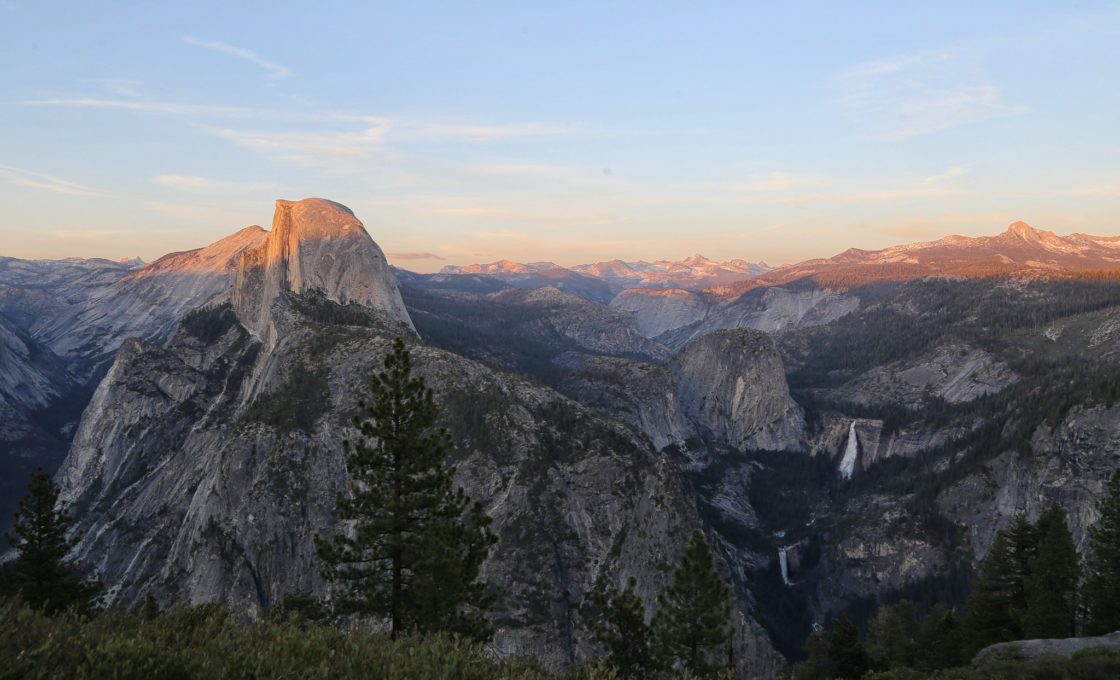
20. Washburn Point
If you’re heading down Glacier Point Road then you owe it to yourself to also stop at Washburn Point for its unforgettable views of the Yosemite Valley and Half Dome.
It’s a similar view from Glacier Point, but you’ll get a better view of Illilouette Falls (along with Vernal and Nevada Fall) and a different perspective of Half Dome. The viewpoint is easily accessed from a staircase located at the parking lot.
21. Olmsted Point
Olmsted Point is another great viewpoint, with sweeping views of Clouds Rest and Half Dome. It’s an easy quarter mile roundtrip hike from the parking lot to check out the view and should only take about a half an hour (at most) to experience.
22. Valley View
Valley View has one of the most iconic views of Yosemite Valley with the Merced River reflecting El Capitan on and the towering Cathedral spires. This is a must-stop for photographers.
It’s usually a good place to stop on your way out of Yosemite Valley and it’s located just after a view of Bridalveil Fall but just before Pohono Bridge. Once you start to see directional signs for highways leaving Yosemite, you should be near it.
23. Crane Flat
Merced Grove of Giant Sequoias
The Merced Grove of Giant Sequoias is found on the Big Oak Flat Road west of Crane Flat.
You can check out about two dozen mature giant sequoias after setting out on a 1.5-mile hike with 500 feet of elevation loss (the return is considered to be strenuous).
Tuolumne Grove of Giant Sequoias
Tuolumne Grove of Giant Sequoias is located on the Tioga Road just east of Crane Flat.
The grove is home to about two dozen mature giant sequoias and they are visible after a one-mile hike with 500 feet of elevation loss (the return is considered to be strenuous).
The Crane Flat Snow Play Area
The Crane Flat Snow Play Area is a great place to take the family to do some sledding and have some fun n the snow.
It is located just south of the Crane Flat gas station, near the Crane Flat Campground and the snow play area is open when there’s adequate snowfall in the area.
24. Yosemite Stargazing
This park gets really dark with minimal light pollution. There are some amazing time lapses put together of this park showcasing the Milky Way and are worth watching.
At Glacier Point, during the summer, they have observatory nights during the summer where you can view planets and galaxies with the help of professional astronomers so look into that.
If you can’t make it up there in the winter then just find an open spot in the park and look up to check out the amazing astronomy.
25. Dine at Yosemite Restaurants
There are a variety of options in Yosemite for food.
In spring the lines at some of these places around lunch time were getting pretty long, so I can only imagine how they would be in the summer. I can attest to both Degnan’s Deli and Loft as being solid choices for meals, as the sandwiches and pizza we had were good.
But note, if you don’t want to be wasting time in line for food then try to hit up the spots right when they open up for lunch/dinner or take a slightly early lunch.
Interesting history
Like most national parks, Yosemite has a ton of interesting history behind the park. I’ll spare you the history lesson but I’d encourage you to check out some of the documentaries about how the park was started, both geologically and politically.
You won’t likely be surprised that the beginnings involved the ouster of Native Americans and a prolonged fight over the exploitation of natural resources.
Make sure you check out the influence of the eccentric, John Muir, though. He’s a man who played an integral role in this national park and used to do things like climb the tops of trees during thunder storms to experience “treeness.”
National Park Service resources
Yosemite probably has the best online resources for a national park that I’ve ever come across.
The park website has plenty of info and their Youtube channel has tons of well-done videos to help you get informed on the park.
Also, because the park is so popular there are ton of people like me writing about it so you have no excuse not to be informed (unless you were like me my first time out to Yosemite).
Save the best for last
This is really something for foreigners or for people who are making their first trip out to the region. If you’re planning on making a circuit route through the different national parks in the area (e.g., Sequoia, Kings Canyon, Pinnacles) then try to put Yosemite last on the list.
The reason is that while the other parks have much to offer, Yosemite is top dog and you’ll invariably find yourself comparing the other parks to your experience in Yosemite.
Just look at reviews of the other parks and you’ll see constant comments about how Pinnacles National Park is interesting but “doesn’t compare to Yosemite.” Again, this is really a personal preference thing but it’s something to think about.
FAQ
Lower Yosemite Falls
Upper Yosemite Falls
Half Dome
Mariposa Grove
Mist Trail to Vernal and Nevada Falls
Panorama Trail
4-Mile Trail
Cathedral Lakes
Mirror Lake Trail
Taft Point
Permits are distributed by lottery at Recreation.gov (or call (877) 444-6777) and they have one preseason lottery with an application period in March and and daily lotteries during the hiking season.
Mariposa Grove is an area in Yosemite known for its Giant Sequoias. Other locations include the Merced Grove of Giant Sequoias and Tuolumne Grove of Giant Sequoias.
Glacier Point
Washburn Point
Olmsted Point
Tunnel View
Yosemite Falls
Sentinel Falls
Horsetail Fall
Illilouette Falls
Nevada Fall
Vernal Fall
Bridalveil Fall
Wapama Fall
Daniel Gillaspia is the Founder of UponArriving.com and the credit card app, WalletFlo. He is a former attorney turned travel expert covering destinations along with TSA, airline, and hotel policies. Since 2014, his content has been featured in publications such as National Geographic, Smithsonian Magazine, and CNBC. Read my bio.

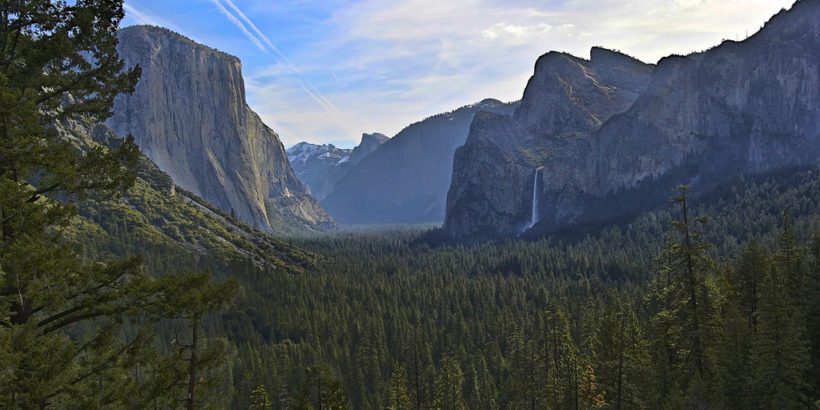
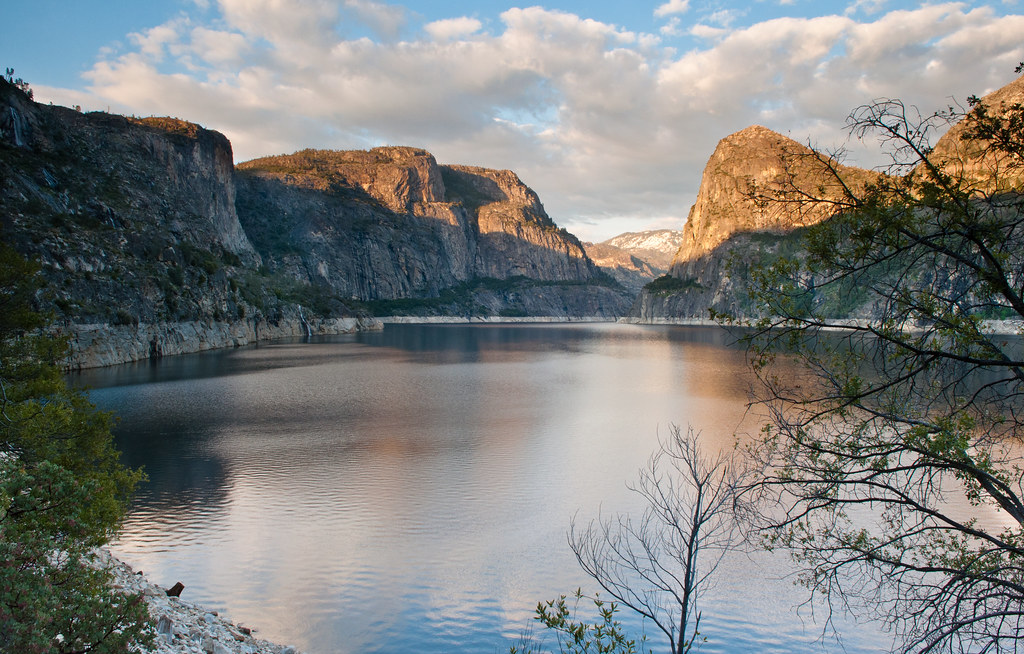

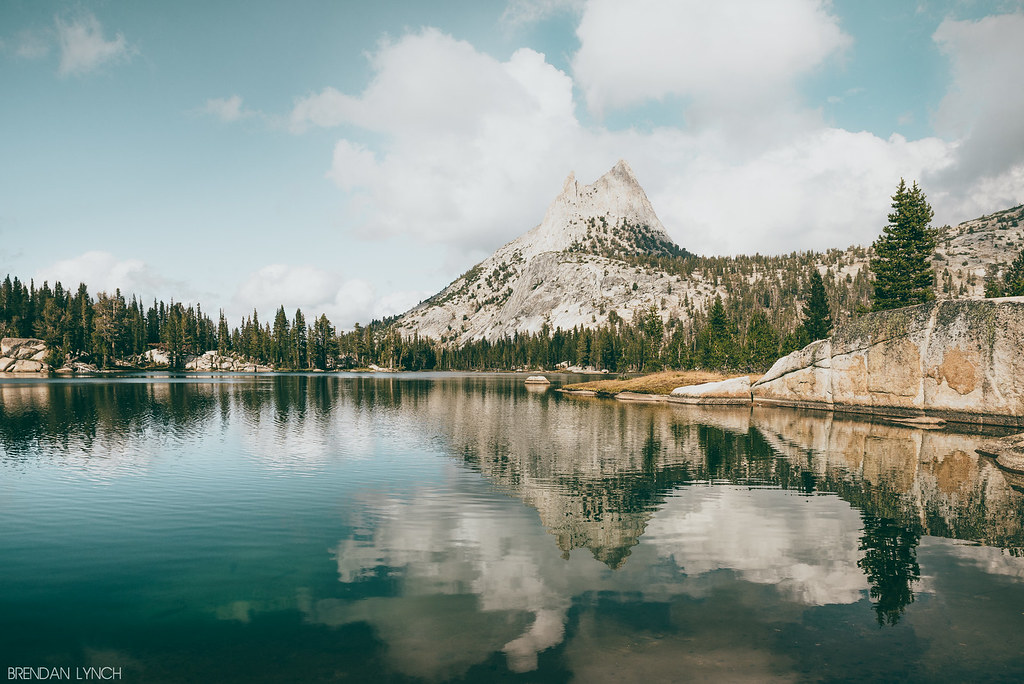
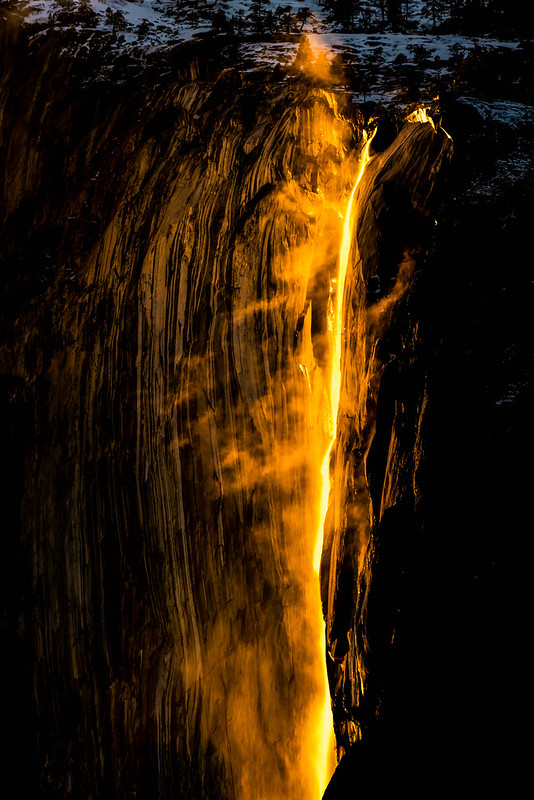
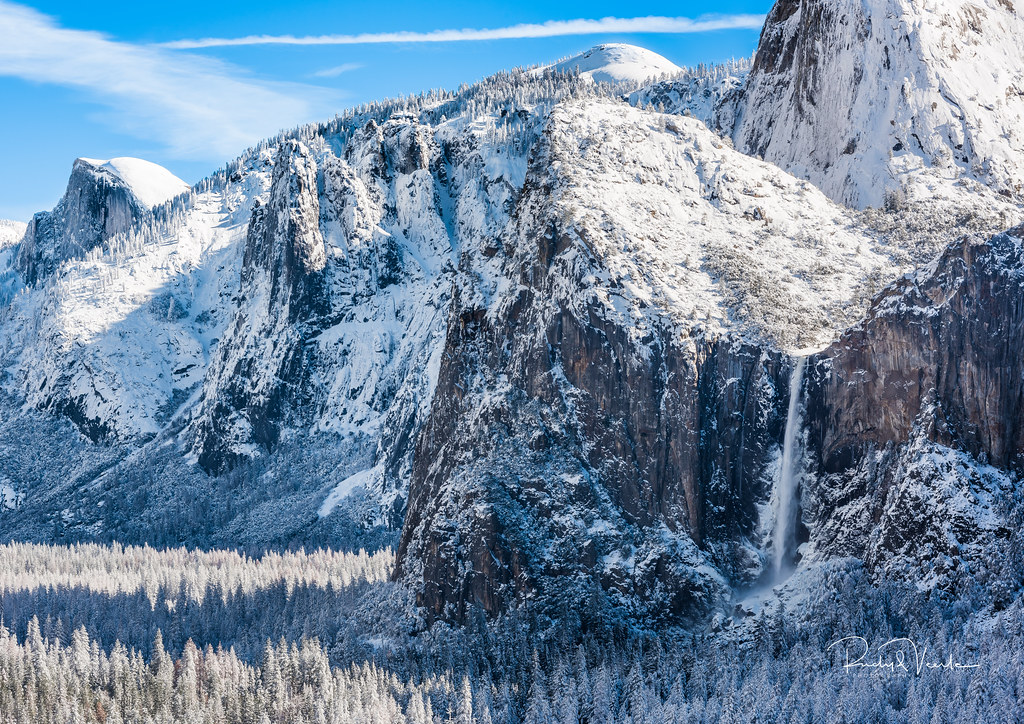
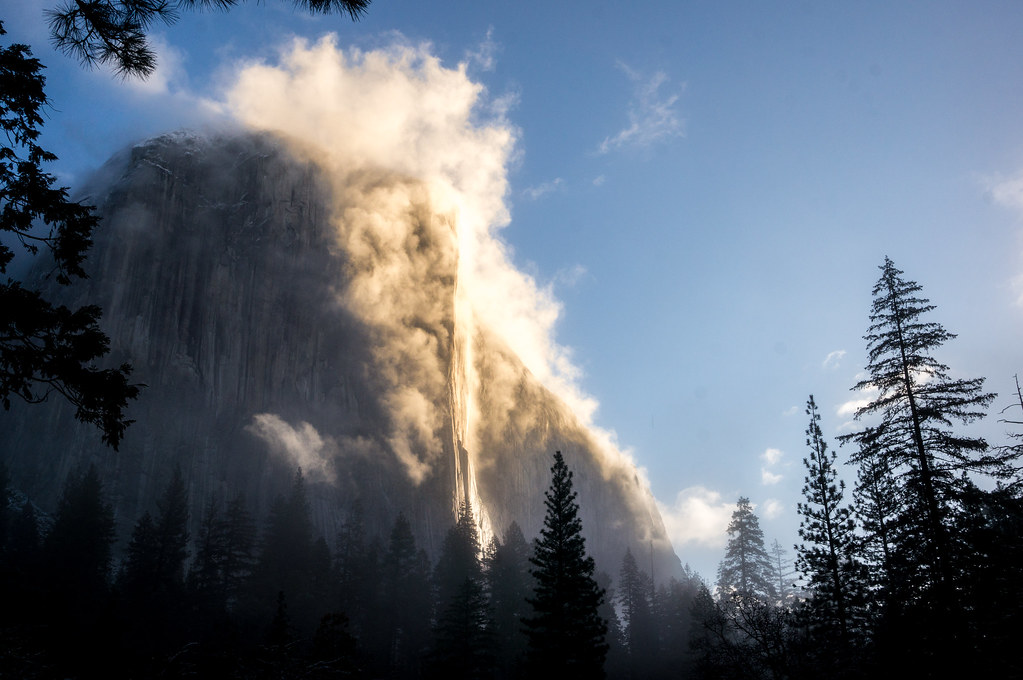
My favorite hike:
On the Tioga Pass Highway at marker T-27 or T-28 (I have forgotten which – not the one with a road widening, but the one with a short dirt road into a dirt parking area used mostly by climbers), walk toward the cliff from the parking lot. Find the trail and turn right onto it for a very short distance. Find the unmarked trail to your left. It goes up the cliff (it’s safe) to near lower Cathedral Lakes. (It is used by rangers to get there quickly for emergencies). The views of Tenaya Canyon and Lake are spectacular. At the top of the cliff, turn left towards the lakes behind Mendicot Dome. (Use your compass and topo map.) The lakes are beautiful. They are locally know as Lakes of the Dome. Camping there is prohibited.
You can continue past the lakes to a viewpoint of the face of Mendicot Dome, probably watching the climbers, then turn back to find the (obvious on your topo) route to a viewpoint of Cathedral Pass. Continuing through that pass (the short bushwhacking is doable is well worth it) to Bud Lake is quite nice, then down the creek to the parking area for the main trail to Cathedral Lakes is easy on unmapped trails. This allows a two car shuttle trip for the entire loop.
I have done this route several times in the direction I indicated. Doing it in reverse would result in less uphill, but would involve very accurate map and compass work to get the Lakes of the Dome, and it might be difficult to find the entrance of the trail down the cliff.
Yes, taking a course in orienteering (topo map reading and compass use for off trail routes) is always helpful to see the best of wildernesses. Else, try ranger hikes (really good in Yosemite, especially in the high country) or Sierra Club (or the like) hikes led by someone like me.
If you try this route, please tell me about it. Has it been changed or upgraded? Thanks.
Thanks – gonna have to seriously look into that route. Sounds awesome.